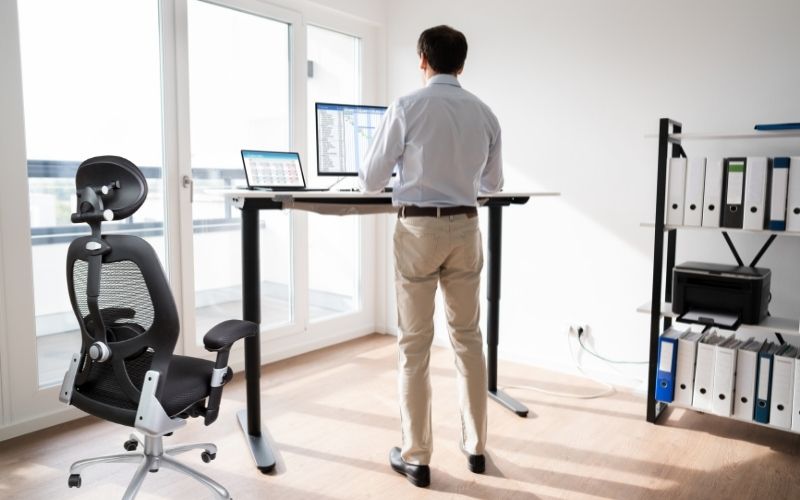Most people work nine to five jobs five days a week. That’s forty hours a week of repetitive stress your body has to endure hunched over a desk, which certainly isn’t good for your physical and mental health.
Research has proven that prolonged sitting is damaging to one’s health and well-being, possibly leading to chronic diseases like diabetes, obesity, and musculoskeletal disorders.
Ergonomics takes into account several disciplines such as psychology, anthropometry, and engineering into the overall design.
By studying the different types of ergonomics, it is possible to rearrange the workspace and its tools in a way that will improve the overall user experience of its workers, creating a comfortable, safe, and productive environment.
In this article, learn about the basics of ergonomics and its importance to the work environment.
Table of Contents
What is Ergonomics?

Ergonomics is the discipline of designing and rearranging products, environments, and systems so that the interactions prioritize a human’s well-being and overall performance.
It is an applied science that seeks to find ways that will make work more productive, efficient, and effective. Also, ergonomics finds ways to improve how humans fit into an environment.
Ergonomics is an interdisciplinary field that mainly draws on anthropometry, psychology, biomechanics, and environmental physics.
Types of Ergonomics
Understanding the types of ergonomics is critical to fully optimize workplace efficiency and job satisfaction.
Physical Ergonomics

This is the most common type of ergonomics applied in work environments. It focuses on reducing the physical load and stresses on the body while performing tasks.
When physical ergonomics is discarded, workers can develop musculoskeletal disorders, chronic diseases, and injuries concerning the nerves, muscles, tendons, ligaments, and blood vessels.
Designing ergonomic tools and equipment is based on a worker’s specific needs for on-site health and safety. Some of the best types of ergonomic office furniture are ergonomic office chairs and sit-to-stand adjustable desks.
Cognitive Ergonomics

This type of ergonomics deals with reducing heavy cognitive load and stress when handling complex and tiresome tasks. This is done by simplifying information and data to complete tasks more efficiently and effectively.
Cognitive ergonomics include the design of software that makes complicated applications into a more user-friendly process. Easy-to-understand data and interfaces remove unnecessary mental stress and ensure that decision-making is accurate.
Organizational Ergonomics

This type of ergonomics focuses on optimizing productivity and product quality through improved teamwork, employee engagement, and job satisfaction.
It can be done through standardized training, data management systems, and improved communication.
How Does Ergonomics Work?

Ergonomics is a multidisciplinary applied science that draws from engineering, physiology, and psychology.
It is influenced the most by these disciplines:
- Anthropometry: human body measurements, shapes, and sizes
- Applied psychology: reducing fatigue, stress, and errors, while optimizing skills and learning
- Biomechanics: effects of forces on the body
- Environmental physics: how humans interact with the environment (light, noise, temperatures, sensations)
- Social psychology: individual and group behaviors, communication, relationships
Why is Ergonomics Important in the Workplace Environment?
Poor ergonomics is one of the top workplace risks experienced by office workers.
Muscular soreness is one of the top causes of absenteeism at work, while back pain is the most common work-related disability.

Maintaining good workplace ergonomics will ensure that work-related injuries and illnesses are prevented while improving productivity and work quality.
Top 5 Benefits of Ergonomics in the Workplace
To give you a better idea of the importance of ergonomics, here are five benefits of studying and applying ergonomics in the workplace:
Improves Productivity

By designing the workplace based on the principles and theories of ergonomics, workers will experience less pain, stress, and physical exertion. This will help them to maintain a good posture that encourages efficient work habits.
Ergonomics makes workplaces feel more comfortable and natural, which does wonders for improving worker focus and productivity.
Improves Work Quality
Employees produce their best work when they’re most comfortable. Fatigue and persistent aches and pains can diminish a person’s ability to focus on producing good work.
By improving workplace conditions, workers will feel less frustrated and tired. This will help them to focus on their given jobs, which is key to getting better results that will fast track their business’ success.
Better Employee Mental Health

Good workplace ergonomics decreases body pain and aches, increases blood flow, and encourages movement. It also decreases anxiety, heightens awareness, manages negative moods, and improves focus.
All of these combined will do wonders for improving workers’ overall mental health and work experience.
Enhances Awareness of Health and Safety
Applying ergonomics in the workplace proves to business workers that their health and safety are valued.
When safety is valued, hazards and other elements that bring discomfort are removed. This helps employees to focus on their tasks and keep their work consistent.
Maintaining unnatural working positions throughout the day leads to tensions and pain in the eyes, neck, back, hips, shoulders, and wrists. If working conditions aren’t improved, you can develop carpal tunnel syndrome, tendonitis, chronic joint pain, diabetes, and obesity.
Fostering a healthy work culture within a company will improve organizational structure and success.

Increases Employee Engagement
When employees notice the company taking care of their health, safety, and well-being, there’s a greater chance they will feel motivated to improve their work.
Improved work ergonomics will lead to fewer employee absenteeism and will give them the morale boost to be more involved in the company. It will also help foster healthier relationships in the workplace.
Conclusion

Studying ergonomics and how it can be applied to your own environment is critical to achieving a productive, safe, efficient, and comfortable workspace.
It is a multidisciplinary science that takes into consideration individual and group strengths, limitations, measurements, sensory abilities, behaviors, and attitudes.
Incorporating physical, cognitive, and organizational ergonomics in the workplace not only reduces the risk of injuries, safety hazards, and illnesses but it also creates a healthy workplace culture that values the worker above all else.
This will improve work satisfaction and quality, which will ultimately lead to organizational success.

My name is Vance, and I am the owner of To Ergonomics. Our mission is to improve your workflow by helping you create a supportive and welcoming environment. We hope that you’ll find what you’re looking for while you’re here.

